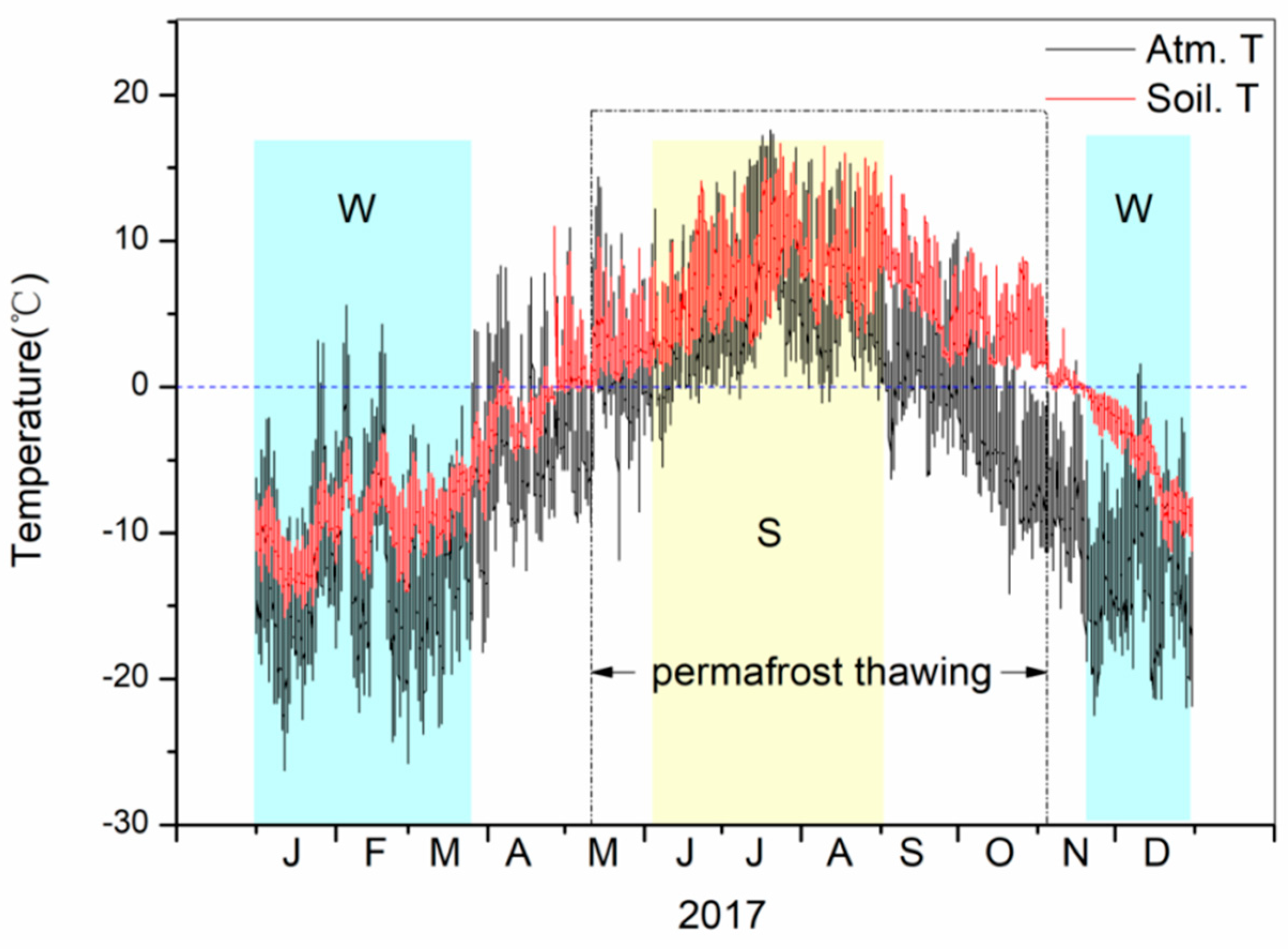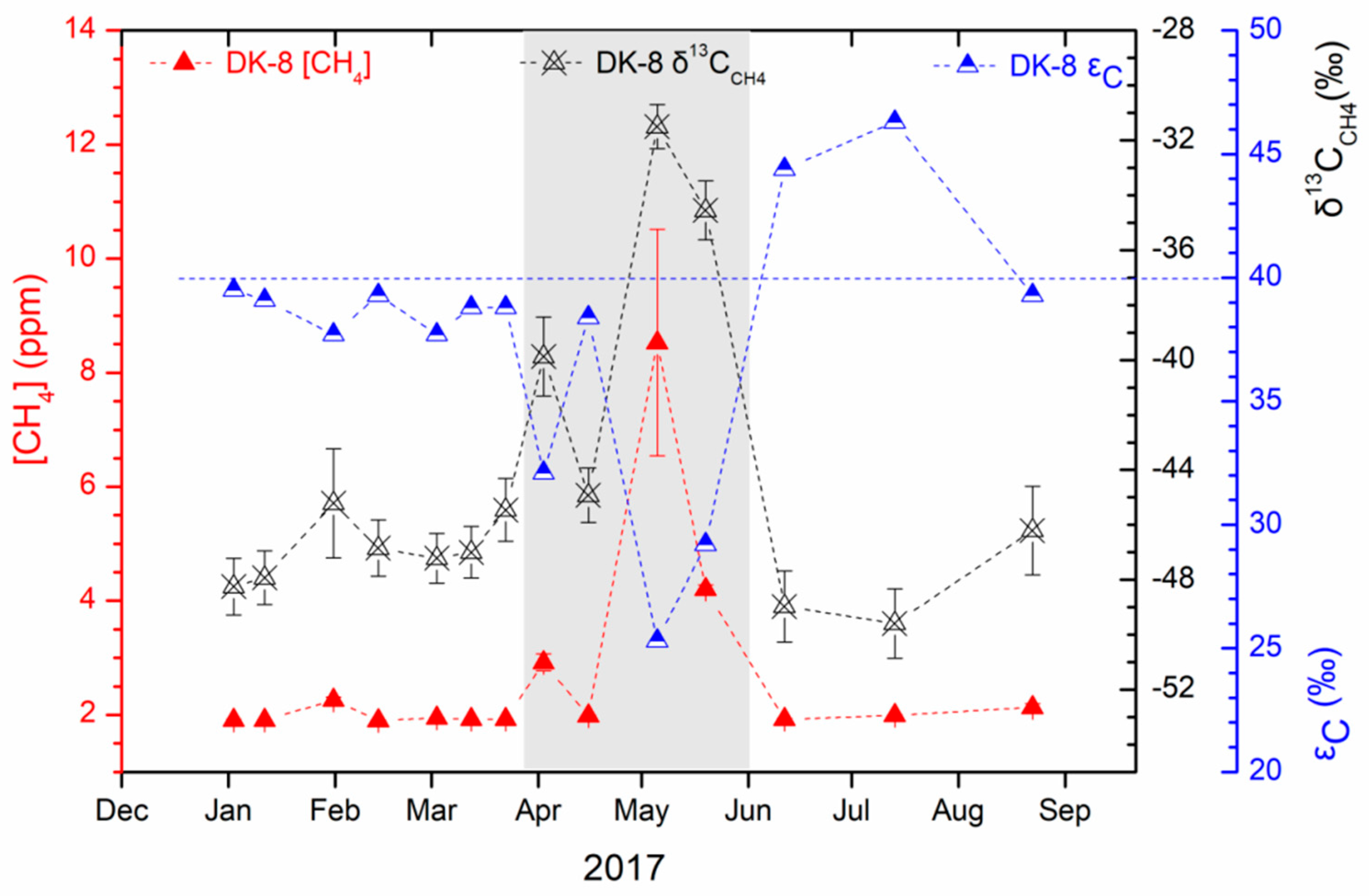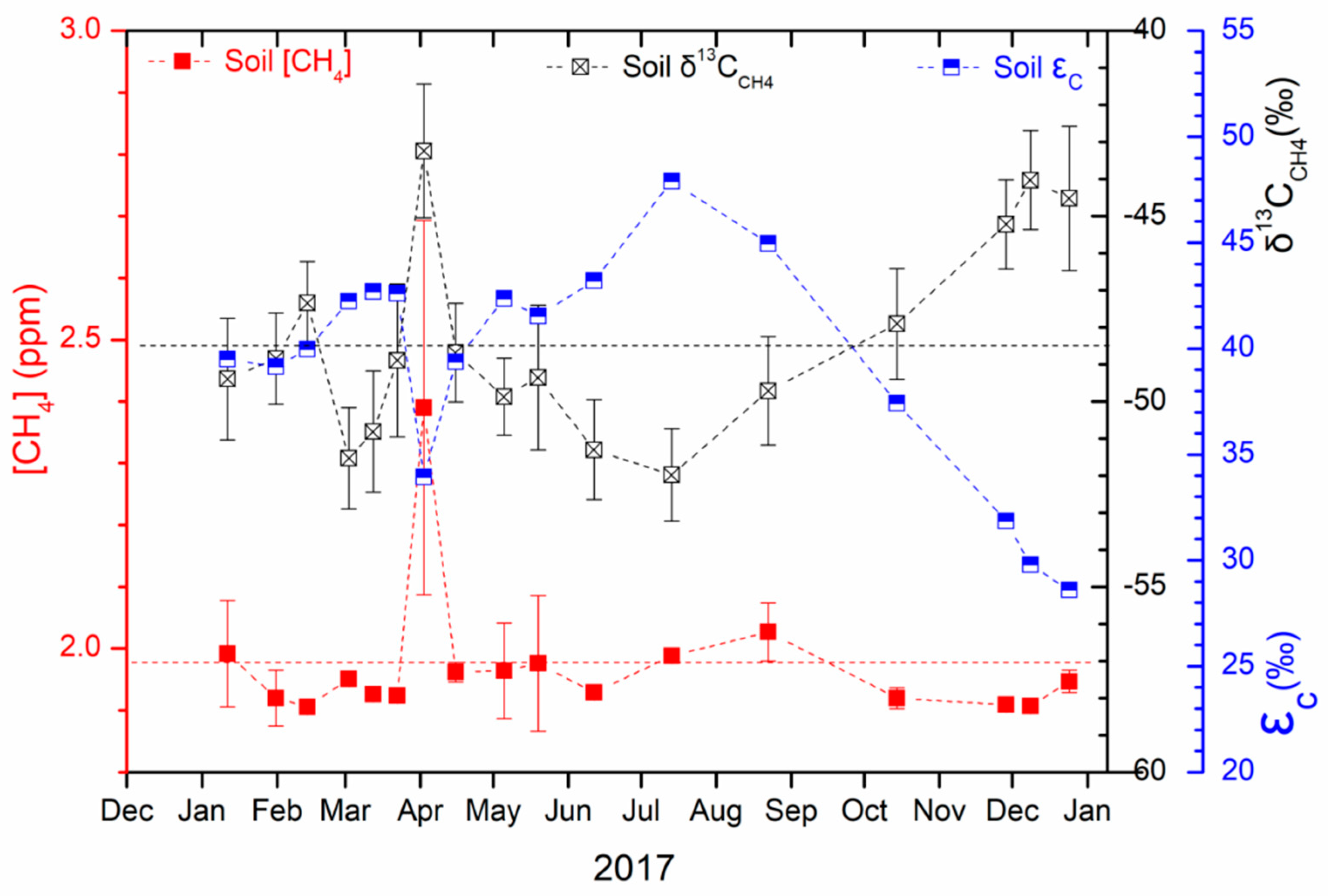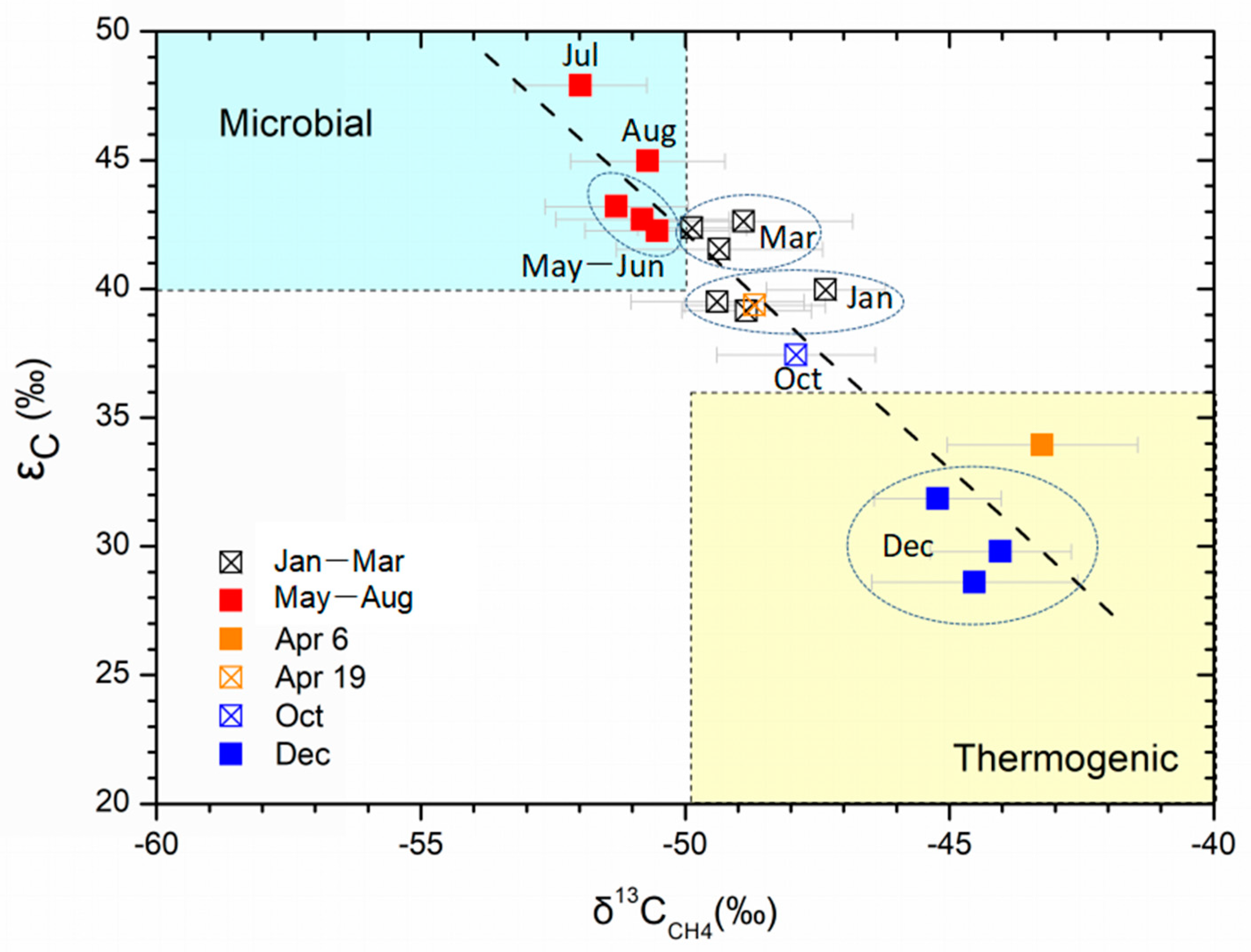Carbon Isotopic Evidence for Gas Hydrate Release and Its Significance on Seasonal Wetland Methane Emission in the Muli Permafrost of the Qinghai-Tibet Plateau
Abstract
:1. Introduction
2. Materials and Methods
2.1. Study Area
2.2. Field Monitoring Method
2.3. Measurements and Data Processing
3. Results
3.1. Monthly Temperature Variation of the Soil upper Active Layer
3.2. Methane Content and Carbon Isotopic Compositions Derived from the Drilling Well DK-8
3.3. Methane Content and Carbon Isotopic Compositions of Free Gas from the Upper of Soil Active Layer
4. Discussion
4.1. Carbon Isotopic Signatures for Methane Derived from Gas Hydrate Dissociation
4.2. Sources of Seasonal Wetland Methane Emission Affected by Gas Hydrate Drilling
5. Conclusions
Author Contributions
Funding
Institutional Review Board Statement
Informed Consent Statement
Data Availability Statement
Acknowledgments
Conflicts of Interest
References
- Shindell, D.T.; Faluvegi, G.; Koch, D.M.; Schmidt, G.A.; Unger, N.; Bauer, S.E. Improved Attribution of Climate Forcing to Emissions. Science 2009, 326, 716–718. [Google Scholar] [CrossRef] [PubMed] [Green Version]
- Dalsøren, S.B.; Myhre, C.L.; Myhre, G.; Gomez-Pelaez, A.J.; Søvde, O.A.; Isaksen, I.S.A.; Weiss, R.F.; Harth, C.M. Atmospheric methane evolution the last 40 years. Atmospheric Chem. Phys. 2016, 16, 3099–3126. [Google Scholar] [CrossRef] [Green Version]
- Zhang, Z.; Zimmermann, N.E.; Stenke, A.; Li, X.; Hodson, E.L.; Zhu, G.; Huang, C.; Poulter, B. Emerging role of wetland methane emissions in driving 21st century climate change. Proc. Natl. Acad. Sci. USA 2017, 114, 9647–9652. [Google Scholar] [CrossRef] [PubMed] [Green Version]
- Zimov, S.A.; Schuur, E.A.G.; Chapin, F.S. Permafrost and the Global Carbon Budget. Science 2006, 312, 1612–1613. [Google Scholar] [CrossRef]
- Zimov, S.A.; Davydov, S.P.; Zimova, G.M.; Davydova, A.I.; Schuur, E.A.G.; Dutta, K.; Chapin, F.S., III. Permafrost carbon: Stock and decomposability of a globally significant carbon pool. Geophys. Res. Lett. 2006, 33, L20502. [Google Scholar] [CrossRef] [Green Version]
- Schuur, E.A.G.; Bockheim, J.; Canadell, J.G.; Euskirchen, E.; Field, C.B.; Goryachkin, S.V.; Hagemann, S.; Kuhry, P.; LaFleur, P.M.; Lee, H.; et al. Vulnerability of Permafrost Carbon to Climate Change: Implications for the Global Carbon Cycle. Bioscience 2008, 58, 701–714. [Google Scholar] [CrossRef]
- DeConto, R.M.; Galeotti, S.; Pagani, M.; Tracy, D.; Schaefer, K.; Zhang, T.; Pollard, D.; Beerling, D.J. Past extreme warming events linked to massive carbon release from thawing permafrost. Nature 2012, 484, 87–91. [Google Scholar] [CrossRef]
- Schuur, E.A.G.; McGuire, A.D.; Schädel, C.; Grosse, G.; Harden, J.W.; Hayes, D.J.; Hugelius, G.; Koven, C.D.; Kuhry, P.; Lawrence, D.M.; et al. Climate change and the permafrost carbon feedback. Nature 2015, 520, 171–179. [Google Scholar] [CrossRef]
- Knoblauch, C.; Beer, C.; Liebner, S.; Grigoriev, M.N.; Pfeiffer, E.-M. Methane production as key to the greenhouse gas budget of thawing permafrost. Nat. Clim. Chang. 2018, 8, 309–312. [Google Scholar] [CrossRef] [Green Version]
- Zhao, Z.; Zhang, Y.; Liu, L.; Liu, F.; Zhang, H. Recent changes in wetlands on the Tibetan Plateau: A review. J. Geogr. Sci. 2015, 25, 879–896. [Google Scholar] [CrossRef] [Green Version]
- Mu, C.; Zhang, T.; Wu, Q.; Peng, X.; Cao, B.; Zhang, X.; Cao, B.; Cheng, G. Editorial: Organic carbon pools in permafrost regions on the Qinghai–Xizang (Tibetan) Plateau. Cryosphere 2015, 9, 479–486. [Google Scholar] [CrossRef] [Green Version]
- Ding, J.; Chen, L.; Ji, C.; Hugelius, G.; Li, Y.; Liu, L.; Qin, S.; Zhang, B.; Yang, G.; Li, F.; et al. Decadal soil carbon accumulation across Tibetan permafrost regions. Nat. Geosci. 2017, 10, 420–424. [Google Scholar] [CrossRef] [Green Version]
- Mu, C.; Abbott, B.W.; Norris, A.J.; Mu, M.; Fan, C.; Chen, X.; Jia, L.; Yang, R.; Zhang, T.; Wang, K.; et al. The status and stability of permafrost carbon on the Tibetan Plateau. Earth-Sci. Rev. 2020, 211, 103433. [Google Scholar] [CrossRef]
- Lu, Z.Q.; Zhu, Y.H.; Zhang, Y.Q.; Wen, H.; Li, Y.H.; Liu, C.L. Gas hydrate occurrences in the Qilian Mountain permafrost, Qinghai Province, China. Cold Reg. Sci. Technol. 2011, 66, 93–104. [Google Scholar] [CrossRef]
- Song, Y.; Yang, L.; Zhao, J.; Liu, W.; Yang, M.; Li, Y.; Liu, Y.; Li, Q. The status of natural gas hydrate research in China: A review. Renew. Sustain. Energy Rev. 2014, 31, 778–791. [Google Scholar] [CrossRef]
- Wang, X.; Pan, L.; Lau, H.C.; Zhang, M.; Li, L.; Zhou, Q. Reservoir volume of gas hydrate stability zones in permafrost regions of China. Appl. Energy 2018, 225, 486–500. [Google Scholar] [CrossRef]
- O’Connor, F.M.; Boucher, O.; Gedney, N.; Jones, C.D.; Folberth, G.A.; Coppell, R.; Friedlingstein, P.; Collins, W.J.; Chappellaz, J.; Ridley, J.; et al. Possible role of wetlands, permafrost, and methane hydrates in the methane cycle under future climate change: A review. Rev. Geophys. 2010, 48, RG4005. [Google Scholar] [CrossRef]
- Cui, M.; Ma, A.; Qi, H.; Zhuang, X.; Zhuang, G.; Zhao, G. Warmer temperature accelerates methane emissions from the Zoige wetland on the Tibetan Plateau without changing methanogenic community composition. Sci. Rep. 2015, 5, 11616. [Google Scholar] [CrossRef] [Green Version]
- Dean, J.F.; Middelburg, J.J.; Röckmann, T.; Aerts, R.; Blauw, L.G.; Egger, M.; Jetten, M.S.M.; de Jong, A.E.E.; Meisel, O.H.; Rasigraf, O.; et al. Methane Feedbacks to the Global Climate System in a Warmer World. Rev. Geophys. 2018, 56, 207–250. [Google Scholar] [CrossRef]
- Yu, L.; Wang, H.; Wang, Y.; Zhang, Z.; Chen, L.; Liang, N.; He, J.-S. Temporal variation in soil respiration and its sensitivity to temperature along a hydrological gradient in an alpine wetland of the Tibetan Plateau. Agric. For. Meteorol. 2020, 282–283, 107854. [Google Scholar] [CrossRef]
- Kuhn, M.; Lundin, E.J.; Giesler, R.; Johansson, M.; Karlsson, J. Emissions from thaw ponds largely offset the carbon sink of northern permafrost wetlands. Sci. Rep. 2018, 8, 9535. [Google Scholar] [CrossRef] [PubMed]
- Mu, C.; Li, L.; Wu, X.; Zhang, F.; Jia, L.; Zhao, Q.; Zhang, T. Greenhouse gas released from the deep permafrost in the northern Qinghai-Tibetan Plateau. Sci. Rep. 2018, 8, 4205. [Google Scholar] [CrossRef]
- Song, C.; Xu, X.; Sun, X.; Tian, H.; Sun, L.; Miao, Y.; Wang, X.; Guo, Y. Large methane emission upon spring thaw from natural wetlands in the northern permafrost region. Environ. Res. Lett. 2012, 7, 34009. [Google Scholar] [CrossRef] [Green Version]
- Mestdagh, T.; Poort, J.; De Batist, M. The sensitivity of gas hydrate reservoirs to climate change: Perspectives from a new combined model for permafrost-related and marine settings. Earth-Sci. Rev. 2017, 169, 104–131. [Google Scholar] [CrossRef] [Green Version]
- Maslin, M.; Owen, M.; Betts, R.; Day, S.; Jones, T.D.; Ridgwell, A. Gas hydrates: Past and future geohazard? Philos. Trans. R. Soc. London. Ser. A Math. Phys. Eng. Sci. 2010, 368, 2369–2393. [Google Scholar] [CrossRef]
- Wang, P.K.; Zhu, Y.H.; Lu, Z.Q.; Huang, X.; Pang, S.J.; Zhang, S. Gas hydrate stability zone migration occurred in the Qilian mountain permafrost, Qinghai, Northwest China: Evidences from pyrite morphology and pyrite sulfur isotope. Cold Reg. Sci. Technol. 2014, 98, 8–17. [Google Scholar] [CrossRef]
- China Meteorological Administration. China Greenhouse Gas Bulletin: The State of Greenhouse Gases in the Atmosphere Based on China and Global Observations until 2019. 2020; Volume 9, pp. 1–5. Available online: http://www.cma.gov.cn/root7/auto13139/ (accessed on 15 February 2022). (in Chinese)
- Luo, M.; Huang, H.; Zhang, P.; Wu, Q.; Chen, D. Origins of gas discharging from the Qiangtang Basin in the northern Qinghai–Tibet Plateau, China: Evidence from gas compositions, helium, and carbon isotopes. J. Geochem. Explor. 2014, 146, 119–126. [Google Scholar] [CrossRef]
- Sun, Z.J.; Yang, Z.B.; Mei, H.; Qin, A.H.; Zhang, F.G.; Zhou, Y.L.; Zhang, S.Y.; Mei, B.W. Geochemical characteristics of the shallow soil above the Muli gas hydrate reservoir in the permafrost region of the Qilian Mountains, China. J. Geochem. Explor. 2014, 139, 160–169. [Google Scholar] [CrossRef]
- Zhang, S.Y.; Zhang, F.G.; Shi, Z.M.; Qin, A.H.; Wang, H.Y.; Sun, Z.J.; Yang, Z.B.; Zhu, Y.H.; Pang, S.J.; Wang, P.K. Sources of seasonal wetland methane emissions in permafrost regions of the Qinghai-Tibet Plateau. Sci. Rep. 2020, 10, 7520. [Google Scholar] [CrossRef]
- Zhang, S.Y.; Yang, F.; Zhang, F.G.; Shi, Z.M.; Yang, Z.B.; Zhou, Y.L.; Wang, H.Y. Study on methane emission and isotopic characteristics of wetland in permafrost area of Qinghai Tibet Plateau. Mod. Geol. 2018, 32, 1089–1096. [Google Scholar] [CrossRef]
- Whiticar, M.J. Carbon and hydrogen isotope systematics of bacterial formation and oxidation of methane. Chem. Geol. 1999, 161, 291–314. [Google Scholar] [CrossRef]
- Barker, J.F.; Fritz, P. Carbon isotope fractionation during microbial methane oxidation. Nature 1981, 293, 289–291. [Google Scholar] [CrossRef]
- Zhou, Y.; Guo, D.; Qiu, G.; Cheng, G.; Li, S. Geocryology in China; Science Press: Beijing, China, 2000. (in Chinese) [Google Scholar]
- Wen, H.J.; Shao, L.Y.; Li, Y.H.; Lu, J.; Zhang, S.L.; Wang, W.L.; Huang, M. Structural outline and stratigraphic framework of Juhugeng mining area in Muli Coalfield, Tianjun County, Qinghai Province. Geol. Bulletin. 2011, 30, 1823–1828. [Google Scholar] [CrossRef]
- Lu, Z.Q.; Rao, Z.; He, J.X.; Zhu, Y.H.; Zhang, Y.Q.; Liu, H.; Wang, T.; Xue, X.H. Geochemistry of drill core headspace gases and its significance in gas hydrate drilling in Qilian Mountain permafrost. J. Asian Earth Sci. 2015, 98, 126–140. [Google Scholar] [CrossRef]
- Wang, P.K.; Zhu, Y.H.; Lu, Z.Q.; Guo, X.W. Lithology and distribution characteristics of gas hydrate in permafrost area of Qi-lian Mountain. Geol. Bulletin. 2011, 30, 1839–1850. [Google Scholar]
- Li, B.; Sun, Y.H.; Guo, W.; Shan, X.L.; Wang, P.K.; Pang, S.J.; Jia, R.; Zhang, G.B. The mechanism and verification analysis of permafrost-associated gas hydrate formation in the Qilian Mountain, Northwest China. Mar. Pet. Geol. 2017, 86, 787–797. [Google Scholar] [CrossRef]
- Zhu, Y.H.; Zhang, Y.Q.; Wen, H.J.; Lu, Z.Q.; Jia, Z.Y.; Li, Y.H.; Li, Q.H.; Liu, C.L.; Wang, P.K.; Guo, X.W. Gas Hydrates in the Qilian Mountain Permafrost, Qinghai, Northwest China. Acta Geol. Sin. 2010, 84, 1–10. [Google Scholar] [CrossRef]
- Lu, Z.; Zhu, Y.; Zhang, Y.; Wen, H.; Li, Y.; Jia, Z.; Wang, P.; Li, Q. Study on genesis of gases from gas hydrate in the Qilian Mountain Permafrost, Qinghai. Geoscience 2010, 24, 581–588. [Google Scholar] [CrossRef]
- Keeling, C.D. The concentration and isotopic abundances of atmospheric carbon dioxide in rural areas. Geochim. Cosmochim. Acta 1958, 13, 322–334. [Google Scholar] [CrossRef]
- Miller, J.B.; Tans, P.P. Calculating isotopic fractionation from atmospheric measurements at various scales. Tellus B Chem. Phys. Meteorol. 2003, 55, 207–214. [Google Scholar] [CrossRef]
- Campeau, A.; Wallin, M.B.; Giesler, R.; Löfgren, S.; Mörth, C.-M.; Schiff, S.; Venkiteswaran, J.J.; Bishop, K. Multiple sources and sinks of dissolved inorganic carbon across Swedish streams, refocusing the lens of stable C isotopes. Sci. Rep. 2017, 7, 9158. [Google Scholar] [CrossRef] [PubMed]
- Liu, C.; He, X.; Meng, Q.; Ye, Y.; Zhu, Y.; Lu, Z. Carbon and hydrogen isotopic compositions characteristics of the released gas from natural gas hydrates in the Qilian Mountain Permafrost. Rock Miner. Anal. 2012, 31, 489–494. [Google Scholar] [CrossRef]
- Liu, C.L.; Meng, Q.G.; He, X.L.; Li, C.F.; Ye, Y.G.; Lu, Z.Q.; Zhu, Y.H.; Li, Y.H.; Liang, J.Q. Comparison of the characteristics for natural gas hydrate recovered from marine and terrestrial areas in China. J. Geochem. Explor. 2015, 152, 67–74. [Google Scholar] [CrossRef]
- Cheng, B.; Xu, J.B.; Lu, Z.Q.; Li, Y.H.; Wang, W.C.; Yang, S.; Liu, H.; Wang, T.; Liao, Z.W. Hydrocarbon source for oil and gas indication associated with gas hydrate and its significance in the Qilian Mountain permafrost, Qinghai, Northwest China. Mar. Pet. Geol. 2018, 89, 202–215. [Google Scholar] [CrossRef]
- Dai, J.X.; Ni, Y.; Huang, S.; Liao, F.; Yu, C.; Gong, D.; Wu, W. Significant function of coal-derived gas study for natural gas industry development in China. Nat. Gas Geosci. 2014, 25, 1–22. [Google Scholar] [CrossRef]
- Dai, J.X.; NI, Y.Y.; Huang, S.P.; Peng, W.L.; Han, W.X.; Gong, D.Y.; Wei, W. Genetic types of gas hydrates in China. Pet. Explor. Dev. 2017, 44, 887–898. [Google Scholar] [CrossRef]
- Ganesan, A.L.; Stell, A.C.; Gedney, N.; Comyn-Platt, E.; Hayman, G.; Rigby, M.; Poulter, B.; Hornibrook, E.R.C. Spatially Resolved Isotopic Source Signatures of Wetland Methane Emissions. Geophys. Res. Lett. 2018, 45, 3737–3745. [Google Scholar] [CrossRef]
- Schwietzke, S.; Sherwood, O.; Bruhwiler, L.M.P.; Miller, J.; Etiope, G.; Dlugokencky, E.J.; Michel, S.E.; Arling, S.S.J.B.M.V.A.; Vaughn, B.H.; White, J.; et al. Upward revision of global fossil fuel methane emissions based on isotope database. Nature 2016, 538, 88–91. [Google Scholar] [CrossRef]
- Kato, T.; Yamada, K.; Tang, Y.H.; Yoshida, N.; Wada, E. Carbon isotopic signature reveals the geographical trend in methane consumption and production pathways in alpine ecosystems over the Qinghai–Tibetan Plateau. Isot. Environ. Health Stud. 2017, 53, 597–609. [Google Scholar] [CrossRef]
- Fisher, R.E.; France, J.L.; Lowry, D.; Lanoisellé, M.; Brownlow, R.; Pyle, J.A.; Cain, M.; Warwick, N.; Skiba, U.M.; Drewer, J.; et al. Measurement of the 13 C isotopic signature of methane emissions from northern European wetlands. Glob. Biogeochem. Cycles 2017, 31, 605–623. [Google Scholar] [CrossRef] [Green Version]
- Kato, T.; Yamada, K.; Tang, Y.H.; Yoshida, N.; Wada, E. Stable carbon isotopic evidence of methane consumption and production in three alpine ecosystems on the Qinghai–Tibetan Plateau. Atmos. Environ. 2013, 77, 338–347. [Google Scholar] [CrossRef]
- Ji, M.K.; Kong, W.D.; Liang, C.; Zhou, T.Q.; Jia, H.Z.; Dong, X.B. Permafrost thawing exhibits a greater influence on bacterial richness and community structure than permafrost age in Arctic permafrost soils. Cryosphere 2020, 14, 3907–3916. [Google Scholar] [CrossRef]
- Mackelprang, R.; Waldrop, M.P.; DeAngelis, K.M.; David, M.M.; Chavarria, K.L.; Blazewicz, S.J.; Rubin, E.M.; Jansson, J.K. Metagenomic analysis of a permafrost microbial community reveals a rapid response to thaw. Nature 2011, 480, 120–368. [Google Scholar] [CrossRef] [Green Version]
- Chen, Y.L.; Liu, F.T.; Kang, L.Y.; Zhang, D.Y.; Kou, D.; Mao, C.; Qin, S.Q.; Zhang, Q.W.; Yang, Y.H. Large-scale evidence for microbial response and associated carbon release after permafrost thaw. Glob. Chang. Biol. 2021, 27, 3218–3229. [Google Scholar] [CrossRef] [PubMed]
- Gruen, D.S.; Wang, D.; Könneke, M.; Begüm, D.T.; Stewart, L.C.; Goldhammer, T.; Holden, J.F.; Hinrichs, K.-U.; Ono, S. Experimental investigation on the controls of clumped isotopologue and hydrogen isotope ratios in microbial methane. Geochim. Cosmochim. Acta 2018, 237, 339–356. [Google Scholar] [CrossRef]
- McCalley, C.K.; Woodcroft, B.; Hodgkins, S.B.; Wehr, R.; Kim, E.-H.; Mondav, R.; Crill, P.; Chanton, J.P.; Rich, V.I.; Tyson, G.; et al. Methane dynamics regulated by microbial community response to permafrost thaw. Nature 2014, 514, 478–481. [Google Scholar] [CrossRef] [Green Version]








| Sampling Date | [CH4] (ppm) | δ13CCH4 (‰ vs. PDB) | [CO2] (ppm) | δ13CCO2 (‰ vs. PDB) | εC (=δ13CCO2 − δ13CCH4) (‰ vs. PDB) |
|---|---|---|---|---|---|
| DK8 well gas | |||||
| 2017/1/6 | 1.908 ± 0.018 | −48.3 ± 1.0 | 413.6 ± 1.3 | −8.8 ± 0.3 | 39.5 |
| 2017/1/15 | 1.909 ± 0.001 | −47.9 ± 1.0 | 415.9 ± 5.4 | −8.9 ± 0.3 | 39.1 |
| 2017/2/4 | 2.259 ± 0.058 | −45.2 ± 2.0 | 331.4 ± 9.8 | −7.5 ± 0.6 | 37.7 |
| 2017/2/17 | 1.904 ± 0.001 | −46.9 ± 1.0 | 435.8 ± 26.5 | −7.5 ± 1.0 | 39.3 |
| 2017/3/6 | 1.944 ± 0.006 | −47.2 ± 0.9 | 463.6 ± 8.3 | −9.5 ± 0.5 | 37.7 |
| 2017/3/16 | 1.921 ± 0.005 | −47.0 ± 0.9 | 434.2 ± 14.6 | −8.2 ± 0.7 | 38.8 |
| 2017/3/26 | 1.923 ± 0.004 | −45.5 ± 1.1 | 462.7 ± 6.9 | −6.6 ± 1.2 | 38.8 |
| 2017/4/6 | 2.920 ± 0.148 | −39.9 ± 1.4 | 337.9 ± 10.0 | −7.7 ± 0.6 | 32.1 |
| 2017/4/19 | 1.983 ± 0.007 | −44.9 ± 1.0 | 455.1 ± 14.0 | −6.5 ± 1.0 | 38.4 |
| 2017/5/9 | 8.530 ± 1.983 | −31.5 ± 0.8 | 302.6 ± 22.2 | −6.2 ± 0.9 | 25.3 |
| 2017/5/23 | 4.201 ± 0.078 | −34.6 ± 1.1 | 325.9 ± 1.5 | −5.4 ± 1.2 | 29.2 |
| 2017/6/15 | 1.920 ± 0.022 | −49.0 ± 1.3 | 405.6 ± 0.8 | −4.6 ± 1.2 | 44.4 |
| 2017/7/17 | 1.993 ± 0.007 | −49.6 ± 1.3 | 429.6 ± 2.4 | −3.3 ± 0.3 | 46.3 |
| 2017/8/26 | 2.132 ± 0.069 | −46.2 ± 1.6 | 395.0 ± 5.5 | −6.9 ± 0.9 | 39.3 |
| Free gas of the active soil layer (10–30 cm depth) | |||||
| 2017/1/15 | 1.992 ± 0.086 | −49.4 ± 1.6 | 437.9 ± 6.0 | −9.9 ± 0.4 | 39.5 |
| 2017/2/4 | 1.920 ± 0.045 | −48.8 ± 1.2 | 471.3 ± 36.0 | −9.7 ± 2.8 | 39.2 |
| 2017/2/17 | 1.906 ± 0.003 | −47.3 ± 1.2 | 435.4 ± 23.6 | −7.4 ± 0.9 | 40.0 |
| 2017/3/6 | 1.951 ± 0.006 | −50.5 ± 1.4 | 464.2 ± 8.0 | −9.3 ± 0.4 | 41.3 |
| 2017/3/16 | 1.926 ± 0.005 | −50.8 ± 1.6 | 436.3 ± 14.5 | −8.1 ± 0.6 | 42.7 |
| 2017/3/26 | 1.924 ± 0.069 | −48.9 ± 2.1 | 466.9 ± 8.2 | −6.3 ± 1.3 | 42.6 |
| 2017/4/6 | 2.390 ± 0.303 | −43.2 ± 1.8 | 474.6 ± 21.9 | −9.3 ± 0.7 | 33.9 |
| 2017/4/19 | 1.962 ± 0.016 | −48.7 ± 1.3 | 445.8 ± 23.0 | −9.3 ± 0.4 | 39.4 |
| 2017/5/9 | 1.964 ± 0.077 | −49.9 ± 1.0 | 426.5 ± 14.0 | −7.5 ± 0.8 | 42.4 |
| 2017/5/23 | 1.976 ± 0.110 | −49.4 ± 2.0 | 407.6 ± 1.8 | −7.8 ± 0.9 | 41.5 |
| 2017/6/15 | 1.929 ± 0.012 | −51.3 ± 1.4 | 438.4 ± 12.0 | −8.1 ± 0.9 | 43.2 |
| 2017/7/17 | 1.988 ± 0.005 | −52.0 ± 1.2 | 503.5 ± 4.1 | −4.1 ± 0.3 | 47.9 |
| 2017/8/26 | 2.027 ± 0.047 | −50.7 ± 1.5 | 441.8 ± 28.6 | −4.8 ± 0.8 | 46.0 |
| 2017/10/18 | 1.920 ± 0.017 | −47.9 ± 1.5 | 425.3 ± 20.7 | −10.5 ± 1.5 | 37.4 |
| 2017/12/2 | 1.909 ± 0.001 | −45.2 ± 1.2 | 778.7 ± 49.8 | −13.4 ± 1.0 | 31.9 |
| 2017/12/12 | 1.907 ± 0.004 | −44.0 ± 1.3 | 663.2 ± 12.4 | −14.2 ± 1.3 | 29.8 |
| 2017/12/28 | 1.947 ± 0.018 | −44.5 ± 1.9 | 576.4 ± 10.5 | −15.9 ± 2.1 | 28.6 |
Publisher’s Note: MDPI stays neutral with regard to jurisdictional claims in published maps and institutional affiliations. |
© 2022 by the authors. Licensee MDPI, Basel, Switzerland. This article is an open access article distributed under the terms and conditions of the Creative Commons Attribution (CC BY) license (https://creativecommons.org/licenses/by/4.0/).
Share and Cite
Li, X.; Xing, J.; Pang, S.; Zhu, Y.; Zhang, S.; Xiao, R.; Lu, C. Carbon Isotopic Evidence for Gas Hydrate Release and Its Significance on Seasonal Wetland Methane Emission in the Muli Permafrost of the Qinghai-Tibet Plateau. Int. J. Environ. Res. Public Health 2022, 19, 2437. https://doi.org/10.3390/ijerph19042437
Li X, Xing J, Pang S, Zhu Y, Zhang S, Xiao R, Lu C. Carbon Isotopic Evidence for Gas Hydrate Release and Its Significance on Seasonal Wetland Methane Emission in the Muli Permafrost of the Qinghai-Tibet Plateau. International Journal of Environmental Research and Public Health. 2022; 19(4):2437. https://doi.org/10.3390/ijerph19042437
Chicago/Turabian StyleLi, Xiaoqian, Jianwei Xing, Shouji Pang, Youhai Zhu, Shuai Zhang, Rui Xiao, and Cheng Lu. 2022. "Carbon Isotopic Evidence for Gas Hydrate Release and Its Significance on Seasonal Wetland Methane Emission in the Muli Permafrost of the Qinghai-Tibet Plateau" International Journal of Environmental Research and Public Health 19, no. 4: 2437. https://doi.org/10.3390/ijerph19042437
APA StyleLi, X., Xing, J., Pang, S., Zhu, Y., Zhang, S., Xiao, R., & Lu, C. (2022). Carbon Isotopic Evidence for Gas Hydrate Release and Its Significance on Seasonal Wetland Methane Emission in the Muli Permafrost of the Qinghai-Tibet Plateau. International Journal of Environmental Research and Public Health, 19(4), 2437. https://doi.org/10.3390/ijerph19042437







